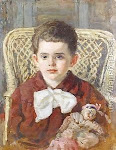(Ferriani in Bamboleide)
 "Jane Anne Campbell" by Ammi Phillips ca.1820
"Jane Anne Campbell" by Ammi Phillips ca.1820
 These miniature women with whom the young child had such close contact with, were a powerful influence. Girls were obliged to grow quickly and to adapt to the image the doll projected, something they did not naturally relate to.
These miniature women with whom the young child had such close contact with, were a powerful influence. Girls were obliged to grow quickly and to adapt to the image the doll projected, something they did not naturally relate to. "Mary Jane Smith" by Joseph Whiting ca. 1838
"Mary Jane Smith" by Joseph Whiting ca. 1838

Classic 9" Milliner's Model, suitable for a large scale dollhouse. Original presentation with molded hairstyle. Pink tulle dress with yellow-painted slippers.

Surrounded by an adult world the child performed actions in play with the doll that imitated those carried out by the mother of the child. She dressed her doll with care for the events of the day and chose suitable accessories from gloves to fans.

These Milliner's Model dolls represent the style of the times for young girls. In the 1830's it was fashionable to wear long white pantaloons or "pantalents" which very often showed beneath the hems of the little girls' dresses.

Portrait of a Victorian child holding a Milliner's Model type doll featuring the young "Queen Victoria" hairstyle, with the braids coiling around, and exposing the ears. This style was popular during the mid 1830's.
 Beautiful doll with child like appearance, ca. 1840- Long curls reaching to shoulders (as worn by girls in period 1840-1860,) featuring glass eyes and slightly opened mouth.
Beautiful doll with child like appearance, ca. 1840- Long curls reaching to shoulders (as worn by girls in period 1840-1860,) featuring glass eyes and slightly opened mouth.From the Rosemann Collection, Heissisches Puppenmuseum.

Though the rigours of the social whirl have left no trace of fatigue on the faces of these dolls, their clothes and hair bear the signs of repeated dressing and undressing, adjustments and re-adjustments….Marco Tosa “Classic Dolls”
 "Raymond Children" by Robert Peckham, 1838
"Raymond Children" by Robert Peckham, 1838Many early nineteenth-century paintings show children holding such dolls. There may have been actual milliner's models before the toy doll of that name came into use, but we do not know how close the resemblance between the two may have been. (This post is #1 of three on Milliner's Model Dolls)













































.jpg)












































































































